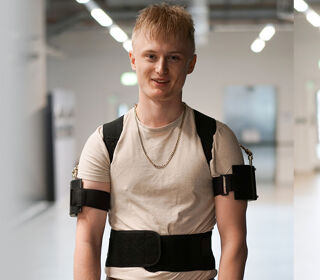
Blog

Enhancing the human body at Innovation Fest
Each year we host Innovation Fest – a two-week celebration of the wonderful projects created by Computing, Engineering and Built Environment students. This year, Innovation Fest was hosted at our new £72 million STEAMhouse building, a state-of-the-art space for collaboration amongst students, academics and businesses.
We sat down with Kyle Burlington, a third-year Mechanical Engineering student, who told us about his exoskeleton project and the inspiration behind it.
Tell us about your project
I have designed and manufactured a full-scale exoskeleton suit prototype, aimed at reducing muscle activity and helping to assist the human body in supporting physical tasks. It does this by providing assistive force to the shoulders and arms. It is lightweight, easy to use, comfortable, and does not require electronics to power it.
The exoskeleton can be used in engineering, construction industries and the military. It reduces muscle activity and stress on the body. As a result, this will make lifting tasks safer, easier and reduce the chance of long-term injuries. The lightweight passive exoskeleton can enhance and improve military soldiers’ capability to lift and carry equipment easier for longer periods of time by providing assistive force to the upper arms combined with a back brace posture correction jacket.
I’ve always had a passion for developing technology that can help enhance the human body. We are at a stage now where this is possible. I feel it’s really important, and with the help of exoskeletons, it can really change people’s lives.
Can you tell us about the process of making your project?
The initial design process involved creating a sketch of my concept using Computer Aided Design (CAD). Following this, calculations were carried out to identify how much assistive force the exoskeleton would provide and to make sure the prototype dimensions were correct, so it fit the user. This was achieved using research I had collected alongside engineering equations.
Whilst designing the prototype, I wanted to ensure it kept its functionality in a variety of environments. I ensured it would not suffer from water exposure by not using electronics. I found this to be a great feature, as it enables the user to use it anywhere and for prolonged periods of time. Another crucial factor I kept in mind during the design process was making it easy to use and suitable for a wide target audience.
The process also involved a lot of complex geometry. The most time-consuming design section and area of the entire project involved achieving the specific dimensions and shapes. The back casing plate support and passive actuator mechanism proved to be the most challenging. I had to take accurate measurements throughout while searching for the components I needed. A lot of the time was spent changing measurements for alternative components I used.
During the modelling stage of the mechanism, I realised there were issues and had to change a lot of things before manufacture. It’s expected that initial designs won’t be perfect which is why the modelling stage is crucial.
How has your course helped you develop the skills needed for your project?
The course has helped me to better myself, improving skills such as problem solving, researching and analysis of data. In terms of the project itself, it really helped me to improve my knowledge of using CAD software, 3D printing and complex ergonomics.
One of the most rewarding parts of my course has been being able to network with industry professionals who encourage the development of future technology. I’m confident that my project shows what I am capable of and demonstrates intricate and high-level skill.
Engineering Courses
Find out more about our courses